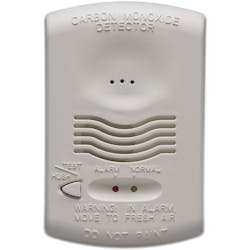Earlier this week, a faulty boiler at an Atlanta elementary school sent more than 30 students and 10 adults to the hospital suffering from symptoms of carbon monoxide poisoning. The incident has sparked calls for the mandatory installation of CO detectors in Georgia schools from parents, as well as state officials. According to the Atlanta Journal-Constitution, however, only two states – Connecticut and Maryland – have such legislation on the books.
While incidents such as these are certainly scary for parents, the fact is that devices such as carbon monoxide and smoke detectors have been designed to protect people that are sleeping, according to fire alarm and codes expert Greg Kessinger, who serves as a regular contributor to SD&I magazine.
"If you were to decide to have (CO detectors) in schools, there would be a lot of things that would have to be discussed first," says Kessinger. "Where you’re going to be overcome by smoke and gas and carbon monoxide is when you are sleeping, so the largest threat currently is residences and hotels/motels and other places where you’re going to find people asleep."
When you’re awake, Kessinger says that more than likely, people will start to feel the symptoms of carbon monoxide poising as the students and staff did at Finch Elementary in Atlanta and realize that something is wrong. "It’s not pleasant, it’s not nice, but it is not a life-threatening problem in facilities where people are alert and awake 24 hours a day," he added.
Kessinger said that he would be more worried about custodial staff and others who may be at the school after hours or prior to a school’s opening that may blow off the warning signs of carbon monoxide poisoning. "Those people would have a tendency to sit down, put their head in the hands and say ‘I’m just going to rest my head for a minute’ and die," he says.
Before lawmakers or anyone else in authority makes a decision to mandate the use of CO detectors, Kessinger says that you really have to weigh what the real dangers to people are. Despite the fact that there are thousands of cases of carbon monoxide poisoning every year, Kessinger says that after you really dig down into the statistics, there really only about 50 deaths per year that could be prevented when you take into consideration suicides, people running generators in basements, etc.
"It’s not the threat nationwide that people believe it is," says Kessinger. "It is preventable, which is the sad part. It takes your life while you’re sleeping."
If schools are going to invest in CO detectors, Kessinger recommends that they place them near the boilers where a problem would originate, rather than in every classroom as some have proposed. What’s really more troubling to Kessinger is that while there have been documented students deaths related to fires; most jurisdictions do not require smoke detectors in schools, but only manual alarms.
As a parent, I can definitely sympathize with those that feel school systems should be taking all of the necessary precautions when it comes to student safety. However, I also believe that we have to step back, as Kessinger says, and look at things objectively before making a knee-jerk reaction. People don’t want to hear about monetary concerns when it comes to safety, but the reality is many school districts across the country still find themselves struggling to make ends meet. Even in Georgia, where this incident occurred, many schools have been forced to make deep budget cuts and implementing effective CO detectors that are not just a band-aid solution will cost schools across the state a significant chuck of change.
About the Author
Joel Griffin
Editor-in-Chief, SecurityInfoWatch.com
Joel Griffin is the Editor-in-Chief of SecurityInfoWatch.com, a business-to-business news website published by Endeavor Business Media that covers all aspects of the physical security industry. Joel has covered the security industry since May 2008 when he first joined the site as assistant editor. Prior to SecurityInfoWatch, Joel worked as a staff reporter for two years at the Newton Citizen, a daily newspaper located in the suburban Atlanta city of Covington, Ga.

